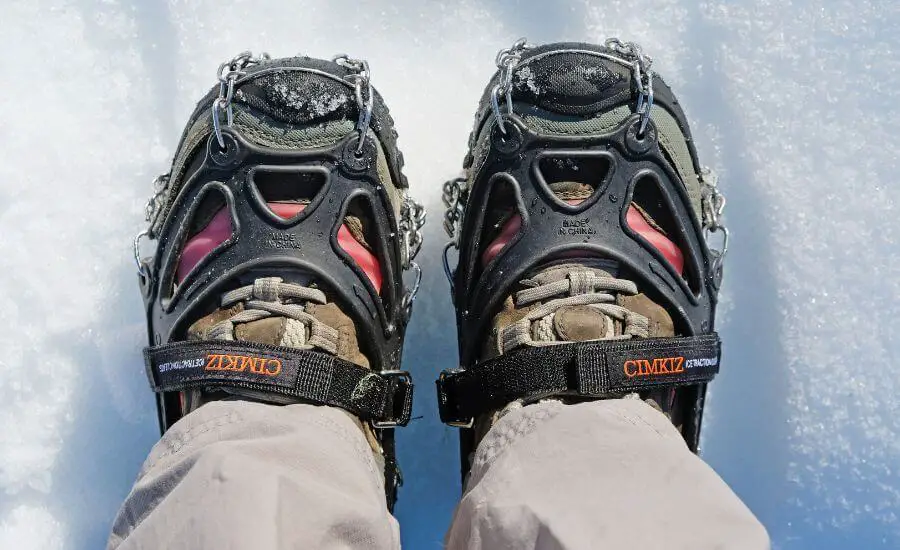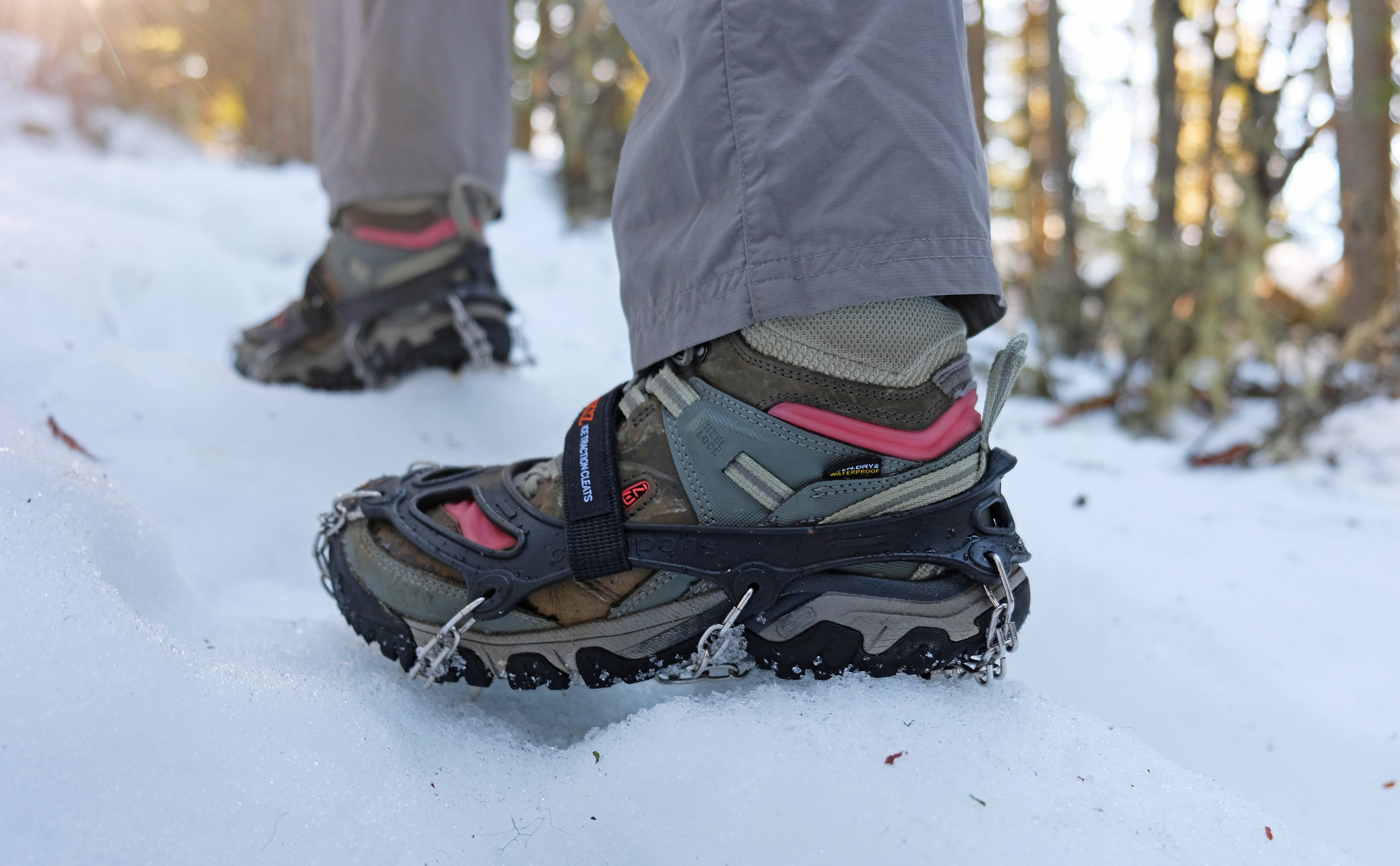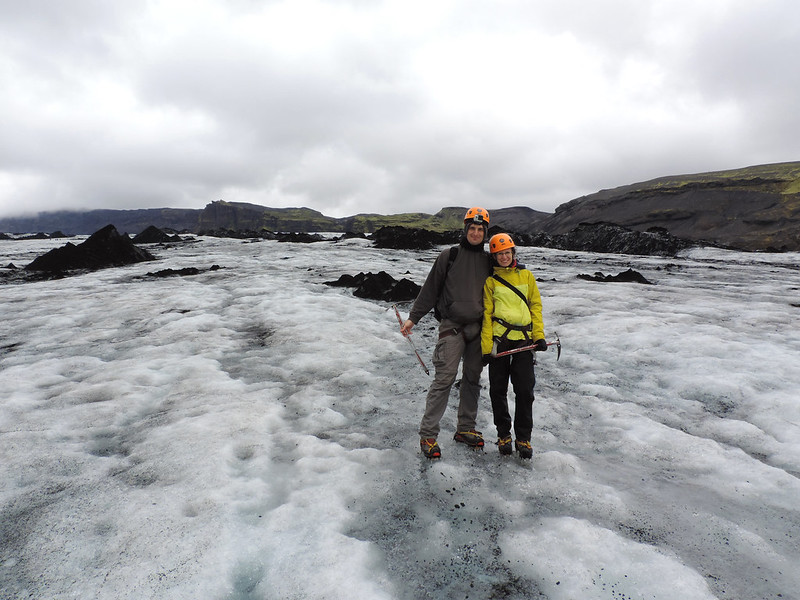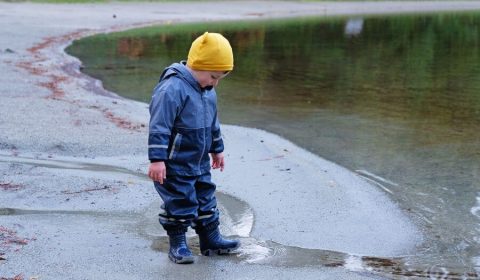What kind of footwear do you need for hiking in the snow? Do you need any traction device? These were our main questions when we started regular winter hiking in British Columbia. In this post we don’t only tell you about the best microspikes for hiking, but also explain what kind of traction devices are available, which one you need for certain activities and what you need to consider when purchasing yours.
Why do we use microspikes on winter hikes? Why should you?
Let’s start with the fact that we had snowy hikes without any kind of traction device for years while we lived in Hungary. Honestly, we haven’t even heard about traction devices. We went for a hike or two each winter in Hungary, usually after fresh snowfalls, and we aimed for moderate trails which could safely be done in the snow. Sometimes it was a mix of snow and mud, and sometimes we slipped. Nothing serious, but it was unpleasant to get so muddy. We didn’t get injured.
After we moved to British Columbia, and winter arrived with lots of snow in Vancouver’s North Shore Mountains, we were excited to explore some of the winter hiking trails. Here we noticed the traction devices, usually microspikes, that other hikers used. We didn’t buy them because we felt the desperate need for them (not after the first fresh snowfalls), but because we wanted to know whether they would make the hiking experience better. Ah, and they do! What’s more important: safer, too.
With a proper grip, we are faster, and hike with more confidence on snow and ice. We don’t slip, trip or slide. Now that we have our microspikes we wear them every time in winter hiking conditions, because they make a huge difference. We do think that it’s worth paying 30-100 USD (that’s the price range for most microspikes on the market) for a safer and more enjoyable winter hike.
Comparison table: the best microspikes for winter hiking
Are you in a hurry? Just skim through our comparison table to find what you’re looking for:
Kahtoola MICROspikes
Pros:
- excellent traction
- durable
- suitable for the backcountry, as well
Cons:
- not the most lightweight
- too aggressive for light snow
Cimkiz Ice Cleats
Pros:
- good traction
- very affordable
Cons:
- not for technical trails
- not that durable
Hillsound Trail Crampon
Pros:
- great for deeper snow and steeper terrain
- excellent traction
Cons:
- bulkier and heavier than others
YakTrax Walk
Pros:
- budget-friendly
- great for urban use
Cons:
- not suitable for deeper snow
- better for walking on icy streets than for hiking
Kahtoola EXOspikes
Pros:
- good performance for trail running or light hiking
Cons:
- not suitable for deeper snow or steep terrain
- “in-between” model, trying to check every box, but not outstanding in any of them
Kahtoola NANOspikes
Pros:
- lightweight
- good grip on hard, flat, icy terrain
Cons:
- not for thick ice or steep terrain
ICETrekkers Diamond Grip
Pros:
- suitable for urban walks and light performance hiking trails
- affordable
Cons:
- not that durable
- not for regular hiking
Snowline Chainsen Ultra
Pros:
- best for technical terrain
- durable, robust design
Cons:
- it might be more than what you actually need
What to consider when choosing hiking microspikes?
The ideal traction device depends on the winter activities you’re planning to use them for. Walking or running on icy pavement is very different from hiking on a snowy ridge trail. In this section we brought some general considerations.
Number and length of spikes
Most microspikes have chains and teeth to provide traction, the most basic ones use chains only. Then there are the cleats which use metal studs and are the easiest for walking, but only work well on a thin layer of ice or snow.
The steeper the trail is, the more aggressive grip you need which means longer spikes. The number of spikes matters, too, but the length and position of the spikes are even more important.
Ease of use
Honestly, most microspikes and cleats are very easy to use. They attach to the bottom of your hiking boot, so you just slip them on. You might prefer one to the other, but all the hiking microspikes we collected in this post are easily usable.
Durability
Durability depends on the materials the microspikes are made of. They usually have an elastic band that slips over the outside of your shoes. If this breaks, your microspikes become useless. Some brands will also note the breaking-point temperature for the elastic harness. It’s worth checking if you plan to hike in extreme cold weather.
The other thing is the quality of the spikes and how quickly they dull. Beware that they are made for snow, ice and soft terrain (like mud). If you often use them on rocks or hard terrain, they’ll dull quickly.
Weight
So the bigger the spikes are, the heavier your equipment will be. You might need the larger spikes and the more aggressive grip for steep winter hikes, but in case you don’t, it’s worth considering the more lightweight options.
Detailed overview: the best microspikes for hiking
Best for the average hiker: Kahtoola MICROspikes
Kahtoola is probably the most popular brand when it comes to microspikes. It offers excellent traction and durability, and the average hiker (or even backpacker) won’t ever need more than what the Kahtoola MICROspikes offer.
It has 12 stainless steel spikes that are connected via (stainless steel) chains. The fit is secure, it’s easily packable and provides stability on steeper terrain and in deeper snow, as well. The only problem with the design is that wet snow (or mud) has a tendency to ball up under the chains. Also, it’s likely an overkill for flat walks, and it’s not what you need for urban walks, as hard terrain dulls the spikes quickly.
The elastic harness retains its elasticity down to -22°F (-30°C).
Best for the beginner hiker: Cimkiz Ice Cleats
The design of these ice cleats are quite similar to the Kahtoola MICROspikes, but it’s more affordable and not as durable. It provides good traction on easy and medium difficulty hiking trails, and it’s great for beginners who don’t want to invest too much in winter hiking equipment yet, or occasional hikers who don’t use it each weekend.
The elastic harness is thick and suitable even for -49°F (-45°C). We used these ice cleats for a full winter season, and even though the chain links could be tougher, we didn’t have any issues with them so far.
Best for steep winter trails: Hillsound Trail Crampon
Naming can be confusing, because the Hillsound Trail Crampon is not a real crampon, but closer to a microspike. Like the models just mentioned, it also has steel spikes linked by chains and an elastomer harness. It does have two small metal plates, but they are not connected by a metal rod (like actual crampons).
It has a secure fit and can handle steeper terrain, because the spikes are large (2/3 inch) and give an aggressive grip. Even though it’s bulkier and heavier than others, if you hike often, and on challenging terrain, you’ll appreciate this model.
Best for urban hikers: YakTrax Walk
The YakTrax Walk is a budget-friendly and easy-to-use solution for urban settings. It has steel coils to provide traction, and they stretch across the bottom of your shoes. It’s very effective on hard, flat terrain, like icy pavement, your icy driveway, or even icy (but flat) gravel trails. However, it won’t provide sufficient traction in deep snow or steep terrain. Also, they wear out fairly quickly, but considering the price, they’re not designed for years of regular use.
Best for winter trail running: Kahtoola EXOspikes
The Kahtoola EXOspikes have 12 tungsten carbide studs for grip. It’s an in-between model: MICROspikes are better for hikers, because they have real steel spikes, and NANOspikes are better for urban runners, with slightly smaller and fewer studs. What are the EXOspikes ideal for? If you more often run on trails than on streets, you’ll like them more than the NANOspikes. They’re suitable for light winter hikes, too, but not for deeper snow or steep terrain.
Best for urban running: Kahtoola NANOspikes
For urban runners the Kahtoola NANOspikes are the best choice. It’s designed to provide traction on hard, flat, icy terrain and ensures safe transition from dry to slippery pavement. It has 10 tungsten carbide studs, attach to your running shoes easily, and it’s really lightweight. But it’s made for icy pavements, boardwalks, roads, and they can’t handle thick ice or steep terrain.
They have a more sturdy build than the YakTrax Walk, and if you use them both for walking and running in urban settings, the NANOspikes is the winner. But they do cost a bit more.
Best for versatile usage: ICETrekkers Diamond Grip
The ICETrekkers Diamond Grip is great for those who would need grippers both in the city and on the (mostly easy) trails. It uses steel alloy strung on steel aircraft cable to provide traction, and the tiny, sharp edges bite into ice and packed snow effectively. It’s more stable than the YakTrax Walk, suitable for the occasional winter hike, given that the terrain is not too steep.
They’re prone to rust and breakage, based on customer experience. If you rinse and dry them after each use, you can lengthen their lifespan, but they likely won’t last more than a season or two. Still, their price is more affordable than most microspikes, and they are more suitable for hard terrain (urban usage).
Best for hiking on technical terrain: Snowline Chainsen Ultra
The Snowline Chainsen Ultra could be an overkill for the average hiker, but it might be just what you need if you often tackle more serious, technical trails. With 14 stainless steel spikes and stainless steel chains that connect them, it’s similar to other hiking microspikes. However, two of the spikes at the front jut out horizontally, which makes it similar to crampons and helps toeing in on steep slopes. The build is robust and durable.
It’s certainly not for everyday use, but its performance on more serious trails is hard to beat.
Winter traction devices FAQ
Microspikes, crampons or snowshoes – which one do you need?
Each of them are designated to give you traction and stability on snow and ice. Wait! Snowshoes are a bit of an exception, because they’re not really traction gear, but winter hiking and snowshoeing might happen on the exact same hiking trail, depending on snow conditions, so we count them in. Each of the three gears are meant for specific conditions.
Microspikes
If you usually hike on easy-medium, well-worn winter trails, microspikes are what you need.
Microspikes are the most common for everyday use, and they’re also called snow grips, ice cleats, hiking cleats, traction cleats or shoe spikes. Their goal is to provide reliable grip on snowy and icy surfaces. Many of them are made of chains and small spikes, and should be placed around your existing footwear – much like snow chains for your tires.
They are more flexible and more lightweight than crampons, but their usage should be limited to flat terrain or gentle slopes, packed snow or ice. Some can handle more technical hiking trails, but when it comes to mountaineering, crampons are what you need. Also, a subset of the microspikes are made specifically for hard terrain, like pavements or roads, their design is a bit different, and they’re effective only on flat terrain.
Crampons
If you need mountaineering crampons, you’re likely not a regular reader on this blog, because we can’t offer much expertise in that topic. 🙂 For the rest of you, here’s a quick intro so that you know what crampons are for.
Crampons were originally designed for ice climbing. They’re foot frames with two steel plates connected by a metal bar, and they should be attached to your footwear (you might need special boots). Their spikes are larger than those on the microspikes. They’re designed to be used on steep, icy slopes (45 degrees and higher) and for technical mountaineering (or ice climbing).
glacier trekking in crampons in Iceland (on a guided hike)
Snowshoes
If you like hiking off the beaten path, or hike after a heavy snowfall, snowshoes are what you need.
Snowshoes don’t give you traction, rather help you float on the snow, like skis. They’re designed for powdery or deep snow on relatively flat terrain. You can argue that snowshoeing is not hiking, but a different kind of winter activity, and you’re partly right, though the boundaries are sometimes not so obvious.
Are microspikes better than crampons?
They have a different usage. Crampons are an overkill for winter hiking on easy-medium difficulty trails, they are bulky and heavy (it’s harder to walk in crampons), the long spikes can hurt your feet if you’re not used to walking in them, and most mountaineering crampons require special boots. Microspikes are more suitable and easier to use for hiking than crampons.
Which is the best traction device for everyday use?
Like running errands in town, walking the dog, shoveling the driveway. Traction gear for everyday wear is quite affordable, but the performance is also limited. These ice grips usually have coils, studs or shallow spikes. However, they are designed for hard surfaces (unlike microspikes), and if you have a pair of them, you won’t wear down your hiking microspikes too soon.
The most affordable option that satisfies daily use is the YakTrax Walk. If you’re an urban runner, and freezing temperatures won’t stop you, the Kahtoola NANOspikes can be sufficient both for running and everyday wear.
Which are the best hiking microspikes?
Hiking cleats usually have plenty of long spikes to provide an aggressive enough grip on rugged terrain. Durable construction is also important, you need robust chains and harnesses to cope with the more challenging terrain (without breaking after the second use or so).
The Kahtoola MICROspikes are the favorite of many hikers, and we think they’re the best choice if you hike regularly on easy-medium difficulty mountain trails, or go backpacking in winter (or in winter conditions – let’s not forget that winter can last until June at high elevations). The Hillsound Trail Crampon might be an overkill for average trail users, but could be a better choice if you often hike on steep terrain, because the spikes are long enough for a more aggressive grip.
As beginners both me and Csaba used these very budget-friendly Cimkiz ice cleats, and we finished a full winter hiking season with satisfaction. I heard about durability issues though, and you need to keep in mind that price more often than not correlates with quality material.
What kind of footwear is suitable to wear with microspikes?
They’re meant to be used with your regular shoes, and elastomer harnesses make it easy to fit. However, some fit better on sports shoes or running shoes (typically the ones designed for urban settings), others offer a more secure fit for hiking boots or fishing boots (typically the hiking microspikes). In general, if the sole of your shoes are too thin, it could mean a less secure fit.
What’s the ideal number of spikes?
More spikes mean more traction. But numbers are not the only thing to care about, the length and position of the spikes is even more important. Kahtoola MICROspikes have 12 spikes, each being 0.38 inches long. The Hillsound Trail Crampon has 11 spikes, 2/3 inch long each – the latter gives more stability on steeper slopes.
Are microspikes usually one-size-fits-all?
No, they are usually NOT. Most brands offer multiple sizes (typically from small to extra large), and you need to check their sizing chart to choose the correct one for your shoe size.
How to take care of your ice cleats?
Actually, they don’t need much care. Rinse and dry them after each use to maximize their lifespan. Don’t use microspikes on bare ground or pavement, because the spikes would dull quickly.
Can you walk on rocks with microspikes?
Microspikes are designed for ice, packed snow or softer terrain, like muddy trails. Using them on hard terrain will dull the spikes quickly, and that includes walking on rocks.
However, we know it will happen, because the snow might not be deep enough during certain sections of the trail to completely cover rocks (especially after the first snowfall, or later in spring when the snow has already started to melt). Microspikes are easy to take on and off, but you still don’t want to do that after every tenth step. So ultimately, you need to decide on mixed terrains whether you need the extra traction or not. A few steps on rocks won’t hurt your spikes, but we wouldn’t recommend walking on rocks regularly.
Can you use microspikes on pavement?
Microspikes are not designed for everyday wear on pavement or roads. It won’t be comfortable (you’ll feel the pressure from the spikes), and you’ll dull the spikes. Ice cleats with coils, studs or very shallow spikes are the way to go for hard, icy terrain.














Leave a Reply